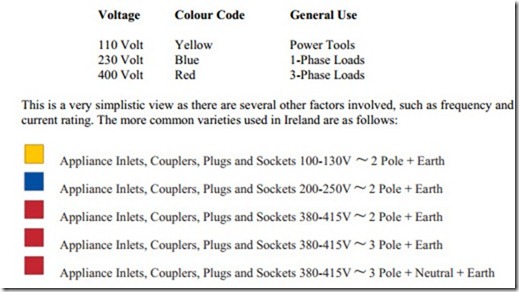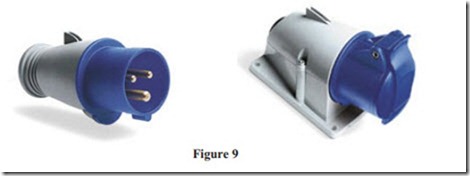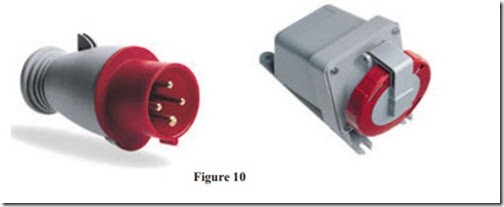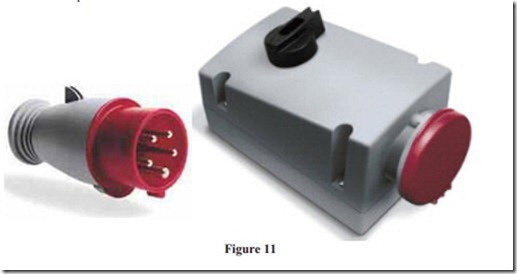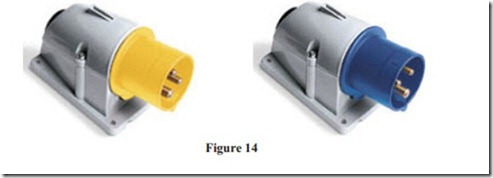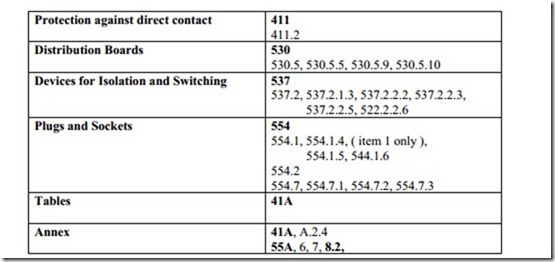Industrial Plugs and Sockets
The most common plug and socket arrangement for general-purpose use indoor is the 13Amp Metal Clad type. It is robust and will provide individual protection for the connection of various portable appliances.
Plugs and sockets for industrial and similar purposes are standardized internationally in the CENELEC member countries according to EN 60309. With respect to onerous environments and outdoors, IP ratings are specified.
They are available in 3, 4 and 5 pin versions, with ratings of 16 Amp, 32 Amp, 63 Amp and 125 Amp. They are also colour coded to allow easy identification of one voltage rating from another. The following three basic voltage ratings are covered in Phase 2.
The EN 60309 standard has made today’s electrical plugs and sockets extremely safe and reliable. Reliability is mainly due to the use of pin-and sleeve connections made of solid brass. The sleeves are equipped with stainless steel springs to ensure constant contact pressure. A further safety feature is the fact that plugs and sockets of differing frequency, voltage or current ratings are not interchangeable. Wherever a plug is used, it will only fit the matching socket. This is achieved firstly by means of a keyway on the socket and a matching key on the plug. In addition to this the earth pin and sleeve positions provide further interlocking.
The twelve, clock positions are used to locate the earth pin and sleeve positions. The keyway of the socket is always at the 6 O’clock position. The earth pin and sleeve are larger diameter and also longer than the other pins and sleeves. This means that the earth is connected first and disconnected last.
The 110 Volt socket earth sleeve is located at the 4 O’clock position. The 230 Volt socket earth sleeve is located at the 6 O’clock position. The 400 Volt socket earth sleeve is located at the 6 O’clock position.
By referring to the chart below, it can be seen that different supplies, voltages and frequencies are catered for in such a way that safety is ensured. The electrician must of course understand the system.
Common Plugs and Sockets
This is a 16 Amp-110 Volt 2 Pole + Earth plug and surface mounted socket. Note the position of the earth pin in the plug. It is in the 8 O’clock position, but remember this will match up with the earth sleeve in the socket which is in the 4 O’clock position.
This is a 16 Amp-230 Volt 2 Pole + Earth plug and surface mounted socket. Note the position of the earth pin in the plug. It is in the 6 O’clock position and will match up with the earth sleeve in the socket which is also in the 6 O’clock position.
This is a 16 Amp- 400 Volt 3 Pole + Earth plug and surface mounted socket. The earth pin in the plug and earth sleeve in the socket are both in the 6 O’clock position.
This is a 16 Amp- 400 Volt 3 Pole + Neutral + Earth plug and surface mounted interlocked switched socket. For safety reasons the plug cannot be inserted or withdrawn when the switch is in the on position. Again the earth pin in the plug and earth sleeve in the socket are both in the 6 O’clock position.
This is a 16 Amp- 110 Volt and a 230 Volt 2 Pole + Earth coupler or trailing socket. These are used on the end of extension leads. They are also used to connect supply to appliances via an appliance inlet. The earth sleeve positions here will be the same as the matching sockets.
This is a 16 Amp- 400 Volt 3 Pole + Earth and a 400 Volt 3 Pole + Neutral + Earth coupler or trailing socket. These are used on the end of extension leads. They are also used to connect supply to appliances via an appliance inlet. The earth sleeve positions here will be the same as the matching sockets.
This is a 16 Amp- 110 Volt and a 230 Volt 2 Pole + Earth surface mounted appliance inlet. These are used to connect power to transportable machines etc. where a flexible cord is undesirable. The earth pin positions here will be the same as the matching plugs.
This is a 16 Amp- 400 Volt 3 Pole + Earth and a 400 Volt 3 Pole + Neutral + Earth, surface mounted appliance inlet. These are used to connect power to transportable machines etc. where a flexible cord is undesirable. The earth pin positions here will be the same as the matching plugs.
Industrial Socket Circuits
EN 60309 socket circuits in industrial premises may also be wired in radial or ring format. In either case the load on the circuit must be assessed and the cables and protective device(s) must be capable of supplying this load. Each socket should be individually protected against overcurrent. The cables used must have a current carrying capacity equal to or greater than the rating of the overcurrent protective device.
Circuits supplying socket outlets must be protected by an RCD with a rated tripping current of 30 mA. There are some exemptions specified in the ETCI rules.
